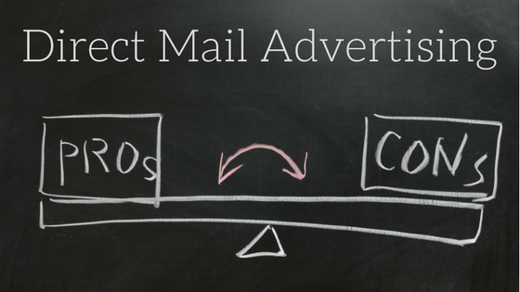 Believe it or not, 80% to 90% of physical mail gets opened daily, and some 57% of total mail volume is attributed to direct mail pieces. What’s more, according to a 2015 survey by MarketingSherpa, 54% of people prefer to learn about promotions and products or services via direct mail; that’s the leading format of choice, ahead of emails at the user’s frequency (49%) and visiting the brand website (38%). And about two-thirds of consumers have bought something due directly to direct mail. These are but a few of the indications that this format is a very valuable tool in your marketing mix, so it’s well worth understanding the pros and cons of direct mail advertising.
Believe it or not, 80% to 90% of physical mail gets opened daily, and some 57% of total mail volume is attributed to direct mail pieces. What’s more, according to a 2015 survey by MarketingSherpa, 54% of people prefer to learn about promotions and products or services via direct mail; that’s the leading format of choice, ahead of emails at the user’s frequency (49%) and visiting the brand website (38%). And about two-thirds of consumers have bought something due directly to direct mail. These are but a few of the indications that this format is a very valuable tool in your marketing mix, so it’s well worth understanding the pros and cons of direct mail advertising.
Cross-platform marketing strategies are a necessity in a multi-device, omnichannel world. At Zimmer, we’ve leveraged them to help our clients accomplish their goals with success. That’s why we’ve created this series” to provide the research to put the strengths and weaknesses of each platform in perspective to help you make the best choices for your advertising campaigns. Today’s post is part five in a series focusing on the pros and cons of each of the additional platforms: Radio, TV, Billboards, Newspaper, and Yellow Page Advertising. To see our last post on the pros and cons of Newspaper, head here, or start with our first post about radio, here.
Pros of Direct Mail Advertising
Easy to Target
Obviously, segmentation and personalization improve any marketing tactic, but the combination of data and customer research make it particularly easy to target direct mail campaigns. This is seen in part by the 4.3% increase in data spending for direct mail campaigns in 2015 as well as the fact that 70% of Americans feel this kind of mail is more personal than digital outreach. Make sure you understand your current customers and potential customers and take advantage of media partners that can help you cue into market analysis that will target niche audiences, segments, and even simple demographics like which street the receiver lives on. Pairing it with digital data can also open up new opportunities through connecting web browsing data and variable printing, like mailing out new touch points based on what the customer viewed on your site.
Easy to Track
Direct mail is well suited to action campaigns, which are already an easy strategy to track. But providing a tangible touchpoint also provides some unique options. For instance, you can track the number of mailed coupons that are redeemed, but you can also generate individualized barcodes for coupons that help note which segments are redeeming them. Similarly, your coupons could feature a phrase or QR code to be utilized on your web store that could track similar information, or a specific vanity URL for a landing page that helps you track traffic. The proof of how easy it is to track direct mail is seen in the firm ROI that can be measured: on average, direct mail offers between 18% and 20% ROI, with 56% of consumers that were motivated to action through direct mail heading to the store or brand site.
Fully Informative with Specific Information
When it comes to brand lift, direct mail offers 70% higher recall than digital counterparts, probably because studies have shown it to require 20% less of the cognitive effort that digital requires. Essentially, direct mail is easier to consume and so easier to recall. This can be as simple as providing store location information and the terms of a coupon discount, but larger mailer formats offer a good deal of real estate on the front and back to share information about your brand, including your USP, and products or services along with your message and CTA.
Cons of Direct Mail Advertising
Cost
Unfortunately, there can be a high cost per contact, and prices may continue to rise as the postal costs continue to increase. The costs can start to stack as well: if you need to rent a contact list, that can cost between $50 and $200 for just 1,000 names. Then, on top of the cost to develop creative, you also need to print it. However, it’s important to remember that advertising is an investment. If you invest in direct marketing wisely, this high cost can yield high impact and bring in the ROI we mentioned earlier.
Can Go Unread
While 98% of Americans check their mail daily, and many spend about 30 minutes with it, only 42% read or scanned the 150 million direct mail promotions sent out in 2015. That number is not insignificant, but it does mean that the majority of those receiving direct mail will throw it away as junk mail without looking at it. Furthermore, you’ll note that the statistic is for “read or scanned,” which means that a not insignificant percentage of those that look at direct mail are not attempting to fully absorb the message you’ve sent them. This may lead to a muddled perception of your brand, but it will definitely impact our next point.
Low Response Rates
While response rates will vary based on which type of direct mail you deploy, on average this format has a 3.7% response rate. (Postcards and oversized envelopes see the strongest rates at 4.25% and 5% respectively.) That’s an unfortunately low number, but it helps to contextualize it. Direct mail offers the second highest response rate for direct media behind only telephone (9% to 10%), and the next highest rate was for mobile at a painful .2%. Even direct response TV only gets a .03% response rate. This should serve to highlight the fact that you need to have a firm understanding of your audience and key into highly targeted and personalized mailings to achieve the best results.
Key Takeaways
The drawbacks to direct mail are considerable enough to approach utilizing this format carefully. There is always the risk that the mail will go unread or merely skimmed, losing or muddling your message, which plays directly into the low response rates. The costs aren’t necessarily as expensive as other formats overall, but they are high in the context of those low rates. That can be tempered by fairly strong ROI on average, which is strengthened by the two leading benefits of direct mail: targeting and tracking. Plus, the fact that the piece of mail can act as a physical reminder (as opposed to ephemeral ads like radio) means that you can provide relatively substantive information that the customer can reference as desired. Here’s a few more tips to keep in mind:
- Always do your homework. You need to understand your audience, how they engage with direct mail, and the type of message that’s going to reach them most effectively before you begin investing in this format.
- Take the time to carefully develop your creative to ensure that your message is on track and that the design of your ad best supports and enhances that message.
- Plan for CTAs and other benchmarks that are easy to track. While direct mail can be used in awareness campaigns, they’re better suited to action campaigns, and that’s the strongest way to ensure you’re seeing solid ROI.
Hopefully, these pros and cons of direct mail advertising will help you identify how the format can be useful to your business in an omnichannel marketing campaign. Don’t miss the final part of our Advertising Format Pros and Cons series which focuses on Yellow Pages advertising. At Zimmer, we’re proud to be able to help our clients develop winning marketing strategies across any platform. Contact us today to discover how we can take your advertising to the next level.

